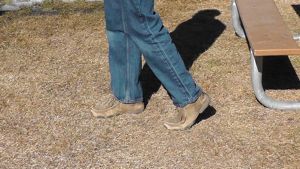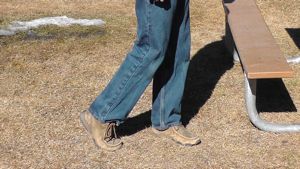Pointing the Way to Better Eyesight
Swinging: Bates Method Technique
To Get Your Eyes Moving
Swinging is a wonderful way to get your visual system moving again.
Remember that the Bates Method tells us that strain leads to poor eyesight and is accompanied by staring. Our eyesight likes to work best when it is effortless and moving.
Part of the process of relearning to see clearly is relearning to incorporate movement into your visual experience.
When your visual system is relaxed, your eyes and mind like to move. Likewise, if you intentionally bring movement to your visual system, it leads to relaxation.
Of course, relaxation is the key to the Bates Method and to having clear effortless eyesight.
So, swinging is a method of allowing movement to be a prominent experience in our visual system.
Look up and away. Breathe. Blink. Then come back!
How It Looks
 |
 |
 |
 |
 |
Stand in a nice posture with your feet about shoulder width apart, or a little more, whatever is comfortable. Gently sway your body from one side to the other keeping your torso, shoulders, neck and head all in alignment together.
So, in other words, when you shift your body weight to the right, your entire head, shoulders, and torso all move to the right together.
Keep your visual attention straight out from your nose!
Not looking at the tip of your nose, but let your gaze be out in the distance as if your nose extended out into the world to touch the objects out there.
Your nose should be in line with the motion of your body and your visual attention in the direction of where your nose is pointing.
Your body will ultimately turn about 180 degrees. Maybe just a little shy, but you can experiment with going a full 180 degrees. When you make it all the way to where the majority of your weight is on the right hand side of your body, the heel of your left foot comes slightly off of the ground. Also, there is a slight rotation on the ball of your left foot to accommodate your body shifting all the way to the right.
And then likewise, when you shift to the left hand side and the majority of your weight is on the left hand side of your body, your right heel slightly comes off of the ground with a slight rotation on the ball of your right foot. Again,this is just to accommodate for your body moving that far in the opposite direction.
 |
 |
Remember that this activity is for relaxation and not really designed as an exercise for your waistline!
It does not have to be vigorous. It does not have to be hard, and it shouldn’t be any more of a strain on your body than simply rocking your body back a forth.
It can also be helpful to keep your arms nice and loose, almost as if they were ropes hanging off of your body with small weights attached to them. Let your arms gently move and sway with the movements of your body. Keep as much of your body as loose and supple as possible.
Swinging and the Joy of Oppositional Movement
The key to this activity bringing relaxation to your visual system is to become aware of the movement of the stationary objects in your field of view.
When you shift your weight form the left foot to the right foot, keeping your body In alignment and your eyes fixed in the direction that your nose is pointing, you will notice that the objects in your field of view seem to move in the opposite direction from which you are moving.
So when you shift to the right, stationary objects will appear to move to the left. This is one of the illusions of eyesight and it is called oppositional movement. It is called oppositional movement because stationary objects have the appearance of moving in the opposite direction from which you are looking.
So as you gently move from side to side, from the left to the right, in an easy, flowing motion, allow yourself to become aware of the oppositional movement of the objects in your field of view.
Think Meditation not Exercise
I find it helpful to think of this activity almost as a meditation rather than an exercise.
I also find it helpful to repeat to myself to relax, let go, and watch the world go by. I gently remind myself every couple of swings and it becomes a type of mantra that helps maintain a relaxed flow and rhythm.
Do not try to see anything in particular! Simply allow the tip of your nose to move across the landscape in front of you and just notice the oppositional movement of stationary objects.
Swinging, when done properly, always helps improve eyesight. Sometimes it can become distracting when clarity returns and the tendency, once you notice that things are becoming clearer, is to want to try to see something. To try and look at something to see it.
Remember when we try to see something, we revert back to staring, and staring creates strain and poor eyesight.
So my suggestion is to just keep moving and keep your eyes in the direction of your nose. Don’t try to see anything and just allow your vision to sweep across that which is before you, noticing the movement of the world.
If the world starts to seem clearer, keep moving, and enjoy the clarity!
When to Practice
Swinging is one of those activities that can be extremely helpful in releasing excess energy.
Sometimes, when we sit down to palm, we can be so tense and jittery in our bodies that it is hard to sit still and allow ourselves to relax into the palming. And when that is the case for me, I like to spend some time swinging first to get my body moving again. Then I am able to relax for the more stationary activities like palming and to some degree sunning.
Its also helpful to practice in the morning when you wake up to sort of set your vision for the day.
Likewise, it is helpful to practice right before going to sleep at night. I find that if I take the time to swing before going to bed, I’m able to relax and sleep more sound and my vision isn’t strained while I sleep.
How Long to Practice
Swinging can be practiced for short periods of time, maybe 50 to 100 rotations. And it can also be practiced for longer periods of time. Sometimes I might swing for 15 to 30 minutes at one time.
You don’t have to go that long to derive benefit - and sometimes it can be extremely helpful.
The key with this activity, as well as with all of the other ones, is that if you find yourself straining and trying to see, then stop and do something else for a little while, and then come back to the swinging. We do not want it to become a strain and an effort.
That is why I like to include the suggestions while swinging: Relax, Let go, and Watch the world go by.
Return to the top of Swinging
Back to Bates Method